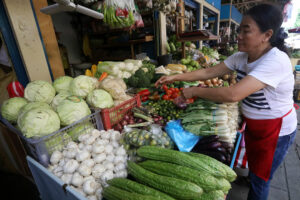




Monthly Economic Update: One for the road
 DOWNLOAD
DOWNLOAD

Inflation Update: Still low, still slow
 DOWNLOAD
DOWNLOAD

Philippines Trade Update: Exports momentum continues
 DOWNLOAD
DOWNLOAD


Inflationary pressures remain elevated in PH

Inflationary pressures in the Philippines remain one of the highest in Asia as food prices continue to rise, according to Nomura Global Markets Research.
Nomura Global Markets Research in a note dated Aug. 30 said the Philippines recorded the second-highest aggregate score of 103.3 in its ranking of inflationary pressures in Asia.
Singapore faces the highest inflationary pressures with a score of 104.
In Nomura’s scorecard, the Philippines is the only emerging market in Asia that still faces elevated risks to inflation.
“(This is) because of the (country’s) higher vulnerability to supply-side inflationary shocks that have spilled over more broadly and will likely unwind only gradually, in our view,” Nomura said.
Headline inflation slowed for a sixth straight month to 4.7% in July but marked the 16th straight month it exceeded the central bank’s 2-4% target.
Inflation averaged 6.8% in the first seven months of the year, still above the central bank’s revised 5.6% full-year forecast.
Nomura noted inflationary pressures were most under control in Indonesia (96.5) and Thailand (96.8).
“Philippines appears most exposed to higher food prices, especially rice (which has an 8.9% weighting in its consumer price index basket). Higher food prices could result in higher headline inflation and a wider current account deficit, as it resorts to importation,” Nomura said.
Rice inflation rose to 4.2% in July from 3.6% in June.
According to Nomura, the bar for all Asian central banks to resume rate hikes is “quite high.”
The BSP earlier this month extended its policy hold for a third straight meeting, keeping the benchmark interest rate at a near 16-year high of 6.25%.
“However, we expect the BSP to leave policy rates unchanged, taking comfort from the sharp drop in core inflation momentum and also due to the weakening growth outlook,” it said.
Nomura expects the BSP to cut rates starting March 2024.
Meanwhile, the Philippine central bank may be “encouraged” to start its policy easing if inflation falls within the 2-4% target range this year, Moody’s Analytics said.
Moody’s Analytics in a report dated Aug. 29 said Asian central banks are “walking on a tightrope” this year as inflation further decelerates but policy movements in the US and in Europe hinder them from cutting down borrowing costs.
“In economies that have slowed recently and where inflation has rapidly moderated, such as in the Philippines and South Korea, central banks may be encouraged to lower their policy rates as soon as inflation reaches their target range,” Moody’s said.
The BSP expects inflation to return to the 2-4% target band in the fourth quarter this year.
“On the other hand, they must watch the policy rate of the US and Europe so as not to allow interest rate gaps to rise further, risking volatility in foreign exchange rates — as seen in recent weeks in Southeast Asia as the yield on the US 10-year bond has risen,” Moody’s said.
The peso closed at PHP 56.725 against the dollar on Wednesday, up by 2.50 centavos from its previous close. Year to date, the peso depreciated by 1.71% or 97 centavos from its PHP 55.755 close on December 29.
“We expect central banks in Asia-Pacific to hold their policy interest rates steady at least through the end of this year, and probably longer, depending upon the stability of domestic demand and their respective currencies and how quickly external demand improves from China and from the European and North American economies,” Moody’s added.
BSP Governor Eli M. Remolona, Jr. earlier said the Philippine central bank remains hawkish, and rate cuts are far off as inflation is still elevated.
The BSP will hold its next policy meeting on September 21. — Keisha B. Ta-asan
This article originally appeared on bworldonline.com





 By BusinessWorld
By BusinessWorld